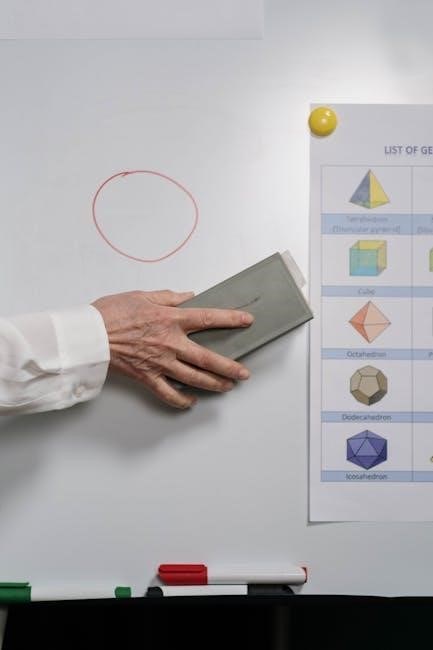Learn to analyze diagrams with online tools and flashcards, studying terms and concepts to complete instructions and find solutions to problems using mathematical formulas and theorems effectively always.
Understanding the Importance of Diagrams in Problem-Solving
Diagrams play a crucial role in problem-solving as they provide a visual representation of the problem, making it easier to understand and analyze. By studying diagrams, individuals can identify key components, recognize patterns, and develop a deeper understanding of the problem. This understanding is essential in developing effective solutions to problems. Online resources, such as flashcards and study guides, can help individuals learn to analyze diagrams and complete instructions effectively. These resources provide a comprehensive overview of the importance of diagrams in problem-solving, including tips and strategies for identifying key components and recognizing patterns. By leveraging these resources, individuals can improve their problem-solving skills and become more proficient in analyzing diagrams to find solutions to complex problems. Effective analysis of diagrams is critical in many fields, including mathematics, science, and engineering.

Identifying Key Components of a Diagram
Identify shapes, symbols, and notations in diagrams to understand relationships and complete instructions effectively always using online tools.
Recognizing Shapes, Symbols, and Notations in Diagrams
To analyze diagrams, it is essential to recognize shapes, symbols, and notations used to represent different components and relationships. Online resources, such as Quizlet, provide flashcards and study materials to help learners identify and understand these elements. By recognizing shapes, such as squares, triangles, and circles, and symbols, such as arrows and lines, individuals can better comprehend the diagram’s meaning and complete instructions accurately. Notations, including numbers and labels, also play a crucial role in diagram analysis, as they provide additional information about the components and their relationships. Effective recognition of these elements enables learners to apply mathematical concepts and formulas to solve problems and find solutions. With practice and experience, individuals can develop their skills in recognizing shapes, symbols, and notations in diagrams, leading to improved analysis and problem-solving abilities. This skill is essential in various fields, including mathematics, science, and engineering.
Applying Mathematical Concepts to Diagrams
Apply mathematical concepts like formulas and theorems to diagrams using online tools and resources to find solutions and complete instructions effectively always with accuracy and precision every time.
Using Formulas and Theorems to Solve Problems in Diagrams
To solve problems in diagrams, it is essential to use formulas and theorems, such as the Pythagorean theorem, which states that c squared equals a squared plus b squared, where c is the hypotenuse. This theorem can be applied to find the missing side length in a right triangle. Additionally, trigonometric ratios like SOH CAH TOA can be used to solve problems in diagrams. These ratios can be applied to find the value of x in a diagram, given the reference angle, hypotenuse length, and opposite length. By using these formulas and theorems, individuals can effectively analyze diagrams and complete instructions to find solutions to problems. Online resources and tools can also be used to practice applying these concepts and to improve problem-solving skills. Effective use of formulas and theorems is crucial to solving problems in diagrams accurately.

Breaking Down Complex Diagrams into Simpler Components
Divide complex diagrams into simpler shapes like triangles and pyramids to analyze and solve problems easily and effectively always using basic geometric concepts.
Identifying Right Triangles, Pyramids, and Other Geometric Shapes in Diagrams
To analyze diagrams, it is essential to identify the different geometric shapes present, such as right triangles, pyramids, and other shapes.
This can be done by looking for familiar patterns and characteristics of each shape, such as the right angle in a right triangle or the base and height of a pyramid.
By identifying these shapes, it becomes easier to apply relevant mathematical concepts and formulas to solve problems.
For instance, the Pythagorean theorem can be used to find the length of a side in a right triangle, while the formula for the volume of a pyramid can be used to calculate its volume.
Additionally, recognizing these shapes can help in breaking down complex diagrams into simpler components, making it easier to analyze and solve problems.
Overall, identifying geometric shapes is a crucial step in analyzing diagrams and solving problems.
It requires attention to detail and a solid understanding of geometric concepts, which can be developed through practice and experience.
With this skill, it becomes possible to tackle a wide range of problems and applications.

Using Trigonometry and Geometry to Analyze Diagrams
Apply trigonometry and geometry concepts to analyze diagrams using formulas effectively always online.
Applying SOH CAH TOA and the Pythagorean Theorem to Solve Problems in Diagrams
To solve problems in diagrams, applying SOH CAH TOA and the Pythagorean Theorem is essential. These concepts help in finding the length of sides and angles in a triangle. The Pythagorean Theorem states that the square of the length of the hypotenuse is equal to the sum of the squares of the lengths of the other two sides. SOH CAH TOA is a mnemonic used to remember the trigonometric ratios sine, cosine, and tangent. By using these concepts, one can analyze diagrams and find the required values. Online resources and flashcards can be used to study and memorize these concepts. Effective application of these theorems and formulas can help in solving problems in diagrams accurately and efficiently, making it easier to complete instructions and find solutions to problems. This requires practice and a good understanding of the concepts involved.

Practicing Analyzing Diagrams with Sample Problems
Practicing with sample problems is crucial to develop skills in analyzing diagrams. Online resources provide a wide range of sample problems, including diagrams with various shapes and instructions to follow. By working through these problems, one can improve their ability to analyze diagrams and complete instructions accurately. Sample problems can include finding the surface area of a composite solid, the volume of a figure, or the value of x in a given diagram. Practicing with different types of problems helps to build confidence and fluency in analyzing diagrams. It also helps to identify areas where more practice is needed, allowing for targeted review and improvement. With consistent practice, one can become proficient in analyzing diagrams and completing instructions, making it easier to solve problems and achieve success. Effective practice requires a systematic approach and a willingness to learn from mistakes.
